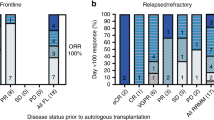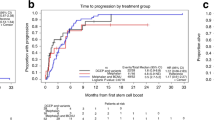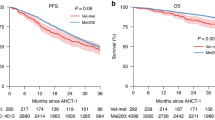Abstract
Single-agent high-dose melphalan (HDM, 200 mg/m2) has been the most commonly used conditioning regimen prior to autologous stem cell transplant, since its introduction in 1992. We used a more aggressive alkylator-based conditioning regimen in an attempt to overcome early relapse and combat drug resistance. We present a retrospective comparison and long-term follow-up of newly diagnosed patients with multiple myeloma (MM) treated with induction followed by either high-dose carmustine (BCNU) and HDM, or HDM alone, both followed by autologous stem cell transplant (ASCT). Between 1997 and 2002, 104 patients were treated with BCNU/HDM; from 2001 to 2008, 103 patients were treated with HDM alone. Median follow-up of survivors was 78 and 68 months for the BCNU/HDM and HDM groups, respectively. The median PFS was significantly increased with the BCNU/HDM regimen (40.4 vs 20.5 months, P<0.001). Median overall survival was increased with the BCNU/HDM regimen when compared with HDM alone (88.4 vs 67.2 months, P=0.07), but the difference was not statistically significant. Transplant-related mortality was similar in both groups (2.9% with BCNU and HDM vs 3.9% with HDM alone). Our findings suggest that the BCNU/HDM preparative regimen should be investigated further and potentially compared in a prospective randomized manner with HDM alone.
This is a preview of subscription content, access via your institution
Access options
Subscribe to this journal
Receive 12 print issues and online access
$259.00 per year
only $21.58 per issue
Buy this article
- Purchase on Springer Link
- Instant access to full article PDF
Prices may be subject to local taxes which are calculated during checkout


Similar content being viewed by others
References
Attal M, Harousseau JL, Stoppa AM, Sotto JJ, Fuzibet JG, Rossi JF et al. A prospective, randomized trial of autologous bone marrow transplantation and chemotherapy in multiple myeloma. Intergroupe Français du Myélome. N Engl J Med 1996; 335: 91–97.
Child JA, Morgan GJ, Davies FE, Owen RG, Bell SE, Hawkins K et al. High-dose chemotherapy with hematopoietic stem-cell rescue for multiple myeloma. N Engl J Med 2003; 348: 1875–1883.
Bladé J, Rosiñol L, Sureda A, Ribera JM, Díaz-Mediavilla J, García-Laraña J et al. High-dose therapy intensification compared with continued standard chemotherapy in multiple myeloma patients responding to the initial chemotherapy: long-term results from a prospective randomized trial from the Spanish cooperative group PETHEMA. Blood 2005; 106: 3755–3759.
Fermand J-P, Katsahian S, Divine M, Leblond V, Dreyfus F, Macro M et al. High-dose therapy and autologous blood stem-cell transplantation compared with conventional treatment in myeloma patients aged 55 to 65 years: long-term results of a randomized control trial from the Group Myelome-Autogreffe. J Clin Oncol 2005; 23: 9227–9233.
Barlogie B, Kyle RA, Anderson KC, Greipp PR, Lazarus HM, Hurd DD et al. Standard chemotherapy compared with high-dose chemoradiotherapy for multiple myeloma: final results of phase III US Intergroup Trial S9321. J Clin Oncol 2006; 24: 929–936.
Cavo M, Palumbo A, Zweegman S, Dimopoulos MA, Hajek R, Pantani L et al. Upfront autologous stem cell transplantation (ASCT) versus novel agent-based therapy for multiple myeloma (MM): a randomized phase 3 study of the European Myeloma Network (EMN02/HO95 MM trial). J Clin Oncol 2016; 34: 8000.
Jasielec JK, Jakubowiak AJ . Current approaches to the initial treatment of symptomatic multiple myeloma. Int J Hematol Oncol 2013; 2: doi:10.2217/ijh.13.3.
Rhee F, van, Giralt S, Barlogie B . The future of autologous stem cell transplantation in myeloma. Blood 2014; 124: 328–333.
Harousseau J-L, Attal M, Leleu X, Troncy J, Pegourie B, Stoppa A-M et al. Bortezomib plus dexamethasone as induction treatment prior to autologous stem cell transplantation in patients with newly diagnosed multiple myeloma: results of an IFM phase II study. Haematologica 2006; 91: 1498–1505.
Popat R, Oakervee HE, Hallam S, Curry N, Odeh L, Foot N et al. Bortezomib, doxorubicin and dexamethasone (PAD) front-line treatment of multiple myeloma: updated results after long-term follow-up. Br J Haematol 2008; 141: 512–516.
Wang M, Giralt S, Delasalle K, Handy B, Alexanian R . Bortezomib in combination with thalidomide-dexamethasone for previously untreated multiple myeloma. Hematology 2007; 12: 235–239.
Richardson PG, Weller E, Lonial S, Jakubowiak AJ, Jagannath S, Raje NS et al. Lenalidomide, bortezomib, and dexamethasone combination therapy in patients with newly diagnosed multiple myeloma. Blood 2010; 116: 679–686.
Barlogie B, Hall R, Zander A, Dicke K, Alexanian R . High-dose melphalan with autologous bone marrow transplantation for multiple myeloma. Blood 1986; 67: 1298–1301.
Moreau P, Facon T, Attal M, Hulin C, Michallet M, Maloisel F et al. Comparison of 200mg/m2 melphalan and 8Gy total body irradiation plus 140mg/m2 melphalan as conditioning regimens for peripheral blood stem cell transplantation in patients with newly diagnosed multiple myeloma: final analysis of the Intergroupe Francophone du Myélome 9502 randomized trial. Blood 2002; 99: 731–735.
Blanes M, de la Rubia J, Lahuerta JJ, González JD, Ribas P, Solano C et al. Single daily dose of intravenous busulfan and melphalan as a conditioning regimen for patients with multiple myeloma undergoing autologous stem cell transplantation: a phase II trial. Leuk Lymphoma 2009; 50: 216–222.
Talamo G, Claxton DF, Dougherty DW, Ehmann CW, Sivik J, Drabick JJ et al. BU and CY as conditioning regimen for autologous transplant in patients with multiple myeloma. Bone Marrow Transplant 2009; 44: 157–161.
Carreras E, Rosiñol L, Terol MJ, Alegre A, de Arriba F, García-Laraña J et al. Veno-occlusive disease of the liver after high-dose cytoreductive therapy with busulfan and melphalan for autologous blood stem cell transplantation in multiple myeloma patients. Biol Blood Marrow Transplant 2007; 13: 1448–1454.
Shimoni A, Smith TL, Aleman A, Weber D, Dimopoulos M, Anderlini P et al. Thiotepa, busulfan, cyclophosphamide (TBC) and autologous hematopoietic transplantation: an intensive regimen for the treatment of multiple myeloma. Bone Marrow Transplant 2001; 27: 821–828.
Ventura GJ, Barlogie B, Hester JP, Yau JC, LeMaistre CF, Wallerstein RO et al. High dose cyclophosphamide, BCNU and VP-16 with autologous blood stem cell support for refractory multiple myeloma. Bone Marrow Transplant 1990; 5: 265–268.
Moreau P, Milpied N, Mahé B, Juge-Morineau N, Rapp MJ, Bataille R et al. Melphalan 220mg/m2 followed by peripheral blood stem cell transplantation in 27 patients with advanced multiple myeloma. Bone Marrow Transplant 1999; 23: 1003–1006.
Reece DE, Nevill TJ, Sayegh A, Spinelli JJ, Brockington DA, Barnett MJ et al. Regimen-related toxicity and non-relapse mortality with high-dose cyclophosphamide, carmustine (BCNU) and etoposide (VP16-213) (CBV) and CBV plus cisplatin (CBVP) followed by autologous stem cell transplantation in patients with Hodgkin’s disease. Bone Marrow Transplant 1999; 23: 1131–1138.
Jagannath S, Armitage JO, Dicke KA, Tucker SL, Velasquez WS, Smith K et al. Prognostic factors for response and survival after high-dose cyclophosphamide, carmustine, and etoposide with autologous bone marrow transplantation for relapsed Hodgkin’s disease. J Clin Oncol 1989; 7: 179–185.
Wheeler C, Antin JH, Churchill WH, Come SE, Smith BR, Bubley GJ et al. Cyclophosphamide, carmustine, and etoposide with autologous bone marrow transplantation in refractory Hodgkin’s disease and non-Hodgkin’s lymphoma: a dose-finding study. J Clin Oncol 1990; 8: 648–656.
Chen AI, Negrin RS, McMillan A, Shizuru JA, Johnston LJ, Lowsky R et al. Tandem chemo-mobilization followed by high-dose melphalan and carmustine with single autologous hematopoietic cell transplantation for multiple myeloma. Bone Marrow Transplant 2012; 47: 516–521.
Stuart MJ, Peters WP, Broadwater G, Hussein A, Ross M, Marks LB et al. High-dose chemotherapy and hematopoietic support for patients with high-risk primary breast cancer and involvement of 4 to 9 lymph nodes. Biol Blood Marrow Transplant 2002; 8: 666–673.
Neppalli AK, Shizuru J, Johnston LJ, Muffly LS, Weng W-K, Negrin R et al. Long-term outcomes of high-dose melphalan and carmustine followed by autologous hematopoietic cell transplantation for multiple myeloma. J Clin Oncol 2016; 34: 8026.
Attal M, Lauwers-Cances V, Marit G, Caillot D, Moreau P, Facon T et al. Lenalidomide maintenance after stem-cell transplantation for multiple myeloma. N Engl J Med 2012; 366: 1782–1791.
McCarthy PL, Owzar K, Hofmeister CC, Hurd DD, Hassoun H, Richardson PG et al. Lenalidomide after stem-cell transplantation for multiple myeloma. N Engl J Med 2012; 366: 1770–1781.
Brenner H, Gondos A, Pulte D . Expected long-term survival of patients diagnosed with multiple myeloma in 2006–2010. Haematologica 2009; 94: 270–275.
Sivaraj D, Green MM, Li Z, Sung AD, Sarantopoulos S, Kang Y et al. Outcomes of maintenance therapy with bortezomib after autologous stem cell transplantation for patients with multiple myeloma. Biol Blood Marrow Transplant 2017; 23: 262–268.
Gao M, Kong Y, Yang G, Gao L, Shi J . Multiple myeloma cancer stem cells. Oncotarget 2016; 7: 35466–35477.
Huff CA, Matsui W, Smith BD, Jones RJ . The paradox of response and survival in cancer therapeutics. Blood 2006; 107: 431–434.
Bahlis NJ . Darwinian evolution and tiding clones in multiple myeloma. Blood 2012; 120: 927–928.
Manier S, Salem KZ, Park J, Landau DA, Getz G, Ghobrial IM . Genomic complexity of multiple myeloma and its clinical implications. Nat Rev Clin Oncol 2017; 14: 100–113.
Rodriguez TE, Hari P, Stiff PJ, Smith SE, Sterrenberg D, Vesole DH . Busulfan, melphalan, and bortezomib versus high-dose melphalan as a conditioning regimen for autologous hematopoietic stem cell transplantation in multiple myeloma. Biol Blood Marrow Transplant 2016; 22: 1391–1396.
Acknowledgements
We gratefully acknowledge the work of the nurses of Adult Bone Marrow Transplant Clinic at Duke University Medical Center. We also acknowledge the work of Beth Mancuso, Astria Wilson, Kelly Corbet, Kenneth Glander and Leslie Digby for their efforts in supporting research and authorship.
Author information
Authors and Affiliations
Corresponding author
Ethics declarations
Competing interests
CG serves as a speaker/consultant/advisor to Celgene, Takeda Oncology and Onyx and has received research funding from Celgene. DAR serves as a speaker to Celgene. The remaining authors declare no conflict of interest.
Rights and permissions
About this article
Cite this article
Sivaraj, D., Bacon, W., Long, G. et al. High-dose BCNU/Melphalan conditioning regimen before autologous stem cell transplantation in newly diagnosed multiple myeloma. Bone Marrow Transplant 53, 34–38 (2018). https://doi.org/10.1038/bmt.2017.208
Received:
Revised:
Accepted:
Published:
Issue Date:
DOI: https://doi.org/10.1038/bmt.2017.208
This article is cited by
-
Adding bendamustine to melphalan before ASCT improves CR rate in myeloma vs. melphalan alone: A randomized phase-2 trial
Bone Marrow Transplantation (2022)
-
Comparison of reduced-toxicity conditioning protocols using fludarabine, melphalan combined with thiotepa or carmustine in allogeneic hematopoietic cell transplantation
Bone Marrow Transplantation (2021)



